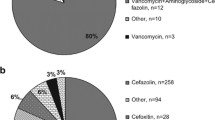Abstract
Objective
To identify the incidence, characteristics and risk factors of nosocomial infections (NIs) in infants and children undergoing open heart surgery, a prospective observational study.
Methods
One hundred consecutive infants and children < 2 yrs of age undergoing open heart surgery (OHS) between March 2007 and December 2007 were included in the study. Samples for blood, endotracheal and urine culture were drawn daily during intensive care unit (ICU) stay. Cultures from endotracheal tube, central venous catheter, arterial cannula, chest tube, urinary catheter and other invasive lines were also obtained. Centers for Disease Control and Prevention criteria were used for defining NIs. A number of possible risk factors predisposing to NI were analyzed.
Results
32% patients developed NI. The NI rate was 49%. Common NIs were bloodstream infection (19%), respiratory tract infection (17%), catheter site infection (7%) and urinary tract infection (6%). Common pathogens were Acinetobacter (22.5%), Pseudomonas aeruginosa (20.4%), Klebsiella pneumoniae (16.3%) and Staphylococcus aureus (12.2%). Major risk factors for NI were length of ICU stay (p < 0.001), duration of intubation (p < 0.001), reintubation (p < 0.001), duration of central venous catheterization (p = 0.001), preoperative congestive heart failure (p = 0.002), tracheostomy (p = 0.003), duration of preoperative stay (p = 0.01), blood transfusion (p = 0.01), preoperative balloon atrial septostomy (p = 0.02), duration of surgery (p = 0.03), surgical complexity score (p = 0.03) and hypothermia (p = 0.03). The mortality rate was 11% with significant association between NI and death (p = 0.002).
Conclusion
NIs develop frequently in infants and children after OHS. This study may serve as a reference point for further development and implementation of interventions aimed at reducing NI rates and improving patient outcome.
Similar content being viewed by others
Explore related subjects
Discover the latest articles and news from researchers in related subjects, suggested using machine learning.References
Bailey & Scott. Diagnostic Microbiology. Ninth Edition. Mosby Year Book, Inc, 1994.
Clinical and Laboratory Standards Institute. Performance Standards for Antimicrobial Susceptibility Testing: Fifteenth Informational Supplement M100-S15. CLSI, Wayne, PA, USA, 2006.
Garner JS, Jarvis WR, Emori TG, Horan TC, Hughes JM. CDC definitions for nosocomial infections. Am J Infect Control 1988;16:128–140.
Alphonso N, Anagnostopoulos PV, Scarpace S, et al. Perioperative antibiotic prophylaxis in paediatric cardiac surgery. Cardiol Young 2007;17:12–25.
Valera M, Scolfaro C, Cappello N, et al. Nosocomial infections in pediatric cardiac surgery, Italy. Infect Control Hosp Epidemiol 2001;22:771–775.
Dagan O, Cox PN, Ford-Jones L, Ponsonby J, Bohn DJ. Nosocomial infection following cardiovascular surgery: comparison of two periods, 1987 vs. 1992. Crit Care Med 1999;27:104–108.
Pollock EM, Ford-Jones EL, Rebeyka I, et al. Early nosocomial infections in pediatric cardiovascular surgery patients. Crit Care Med 1990;18:378–384.
Mantero E, Panizzon G, Tacchella A, et al. Occurrence of hospital infections in a department of pediatric heart surgery. Pediatr Med Chir 1986;8:715–720.
Levy I, Ovadia B, Erez E, et al. Nosocomial infections after cardiac surgery in infants and children: incidence and risk factors. J Hosp Infect 2003;53:111–116.
Tan L, Sun X, Zhu X, Zhang Z, Li J, Shu Q. Epidemiology of nosocomial pneumonia in infants after cardiac surgery. Chest 2004;125:410–417.
Ryan T, Mc Carthy JF, Rady MY, et al. Early bloodstream infection after cardiopulmonary bypass: frequency rate, risk factors, and implications. Crit Care Med 1997;25:2009–2014.
Leal-Noval SR, Rincón-Ferrari MD, García-Curiel A, et al. Transfusion of blood components and postoperative infection in patients undergoing cardiac surgery. Chest 2001;119:1461–1468.
Trouillet JL, Chastre J, Vuagnat A, et al. Ventilator-associated pneumonia caused by potentially drug-resistant bacteria. Am J Respir Crit Care Med 1998;157:531–539.
Rosenthal VD, Maki DG, Salomao R, et al. Device-associated nosocomial infections in 55 intensive care units of 8 developing countries: Ann Intern Med 2006;145:582–591.
Ibrahim EH, Sherman G, Ward S, Fraser VJ, Kollef MH. The influence of inadequate antimicrobial treatment of bloodstream infections on patient outcomes in the ICU setting. Chest 2000;118:146–155.
Jenkins KJ, Newburger JW, Lock JE, Davis RB, Coffman GA, Iezzoni LI. In-hospital mortality for surgical repair of congenital heart defects: preliminary observations of variation by hospital caseload. Pediatrics 1995;95:323–330.
Hannan EL, Racz M, Kavey RE, Quaegebeur JM, Williams R. Pediatric cardiac surgery: the effect of hospital and surgeon volume on in-hospital mortality. Pediatrics 1998;101:963–969.
Author information
Authors and Affiliations
Corresponding author
Rights and permissions
About this article
Cite this article
Hasija, S., Makhija, N., Kiran, U. et al. Nosocomial infections in infants and children after cardiac surgery. Indian J Thorac Cardiovasc Surg 24, 233–239 (2008). https://doi.org/10.1007/s12055-008-0052-y
Received:
Revised:
Accepted:
Published:
Issue Date:
DOI: https://doi.org/10.1007/s12055-008-0052-y




